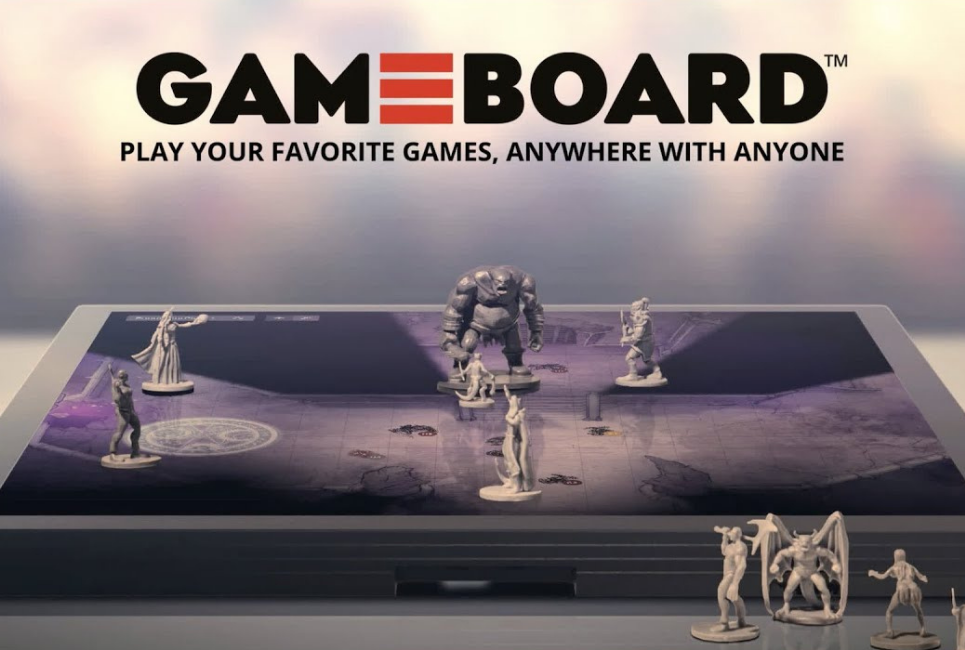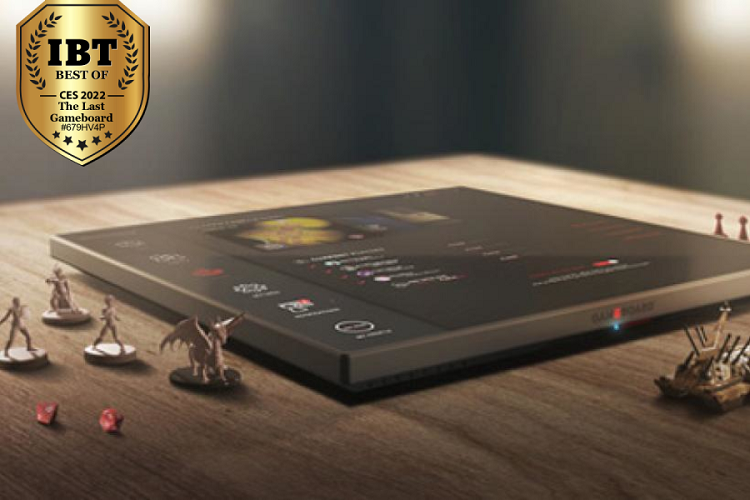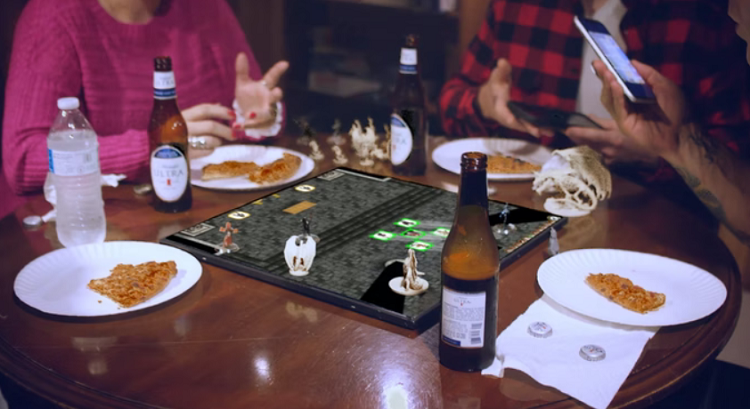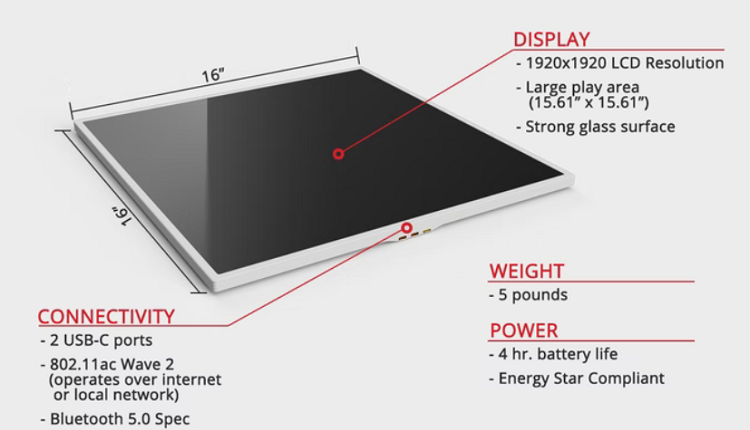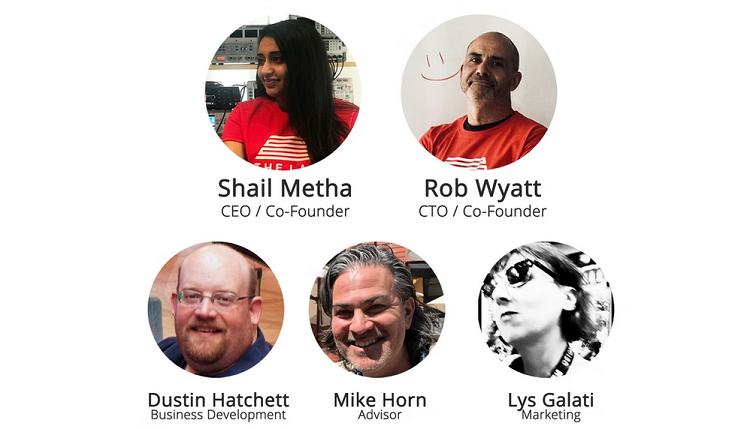Shail Mehta is the CEO of co-founder of The Last Gameboard, a tech startup that’s digitizing and democratizing board games with Gameboard, an immersive gaming tablet.
It’s been a long two years for The Last Gameboard since their Kickstarter launched in December 2019. Everything was running smoothly until 2020 happened and the world, including their production lines, came to a halt.
It was a tough year for startups, but with persistence, patience, and a great team, Shail and the Last Gameboard are on track to deliver their product to Kickstarter backers this year and then to the rest of the world.
I chatted with Shail to find out more about Gameboard, the tech, the software, and we chatted about gaming, tech, gatekeeping in the industry, and the future of board gaming.
Emily: Let’s start by talking about the physical Gameboard itself. How would you describe it to someone who’s never seen it before?
Shail: Gameboard is Peloton meets Netflix. It’s a board game console and it’s a beautifully designed 22-inch display. It’s lightweight, it’s thin, it’s portable, it’s square, there’s WiFi, Bluetooth, speakers, and microphones.
And then when you turn it on, it’s like Netflix as you have access to a library of games. You click on whichever game you want to play and the board will become it.
We also have a patented technology that allows you to use physical pieces. So if you’re playing chess and you have a chess set, you can use it on Gameboard. And you don’t have to have physical pieces. You can play things completely digitally. But I think that a lot of tabletop players like myself like the physical aspect that makes you feel more immersed in the game.
And that’s why we allow this hybrid approach. You don’t have to just be analogue. You don’t have to be mobile gaming, because that’s not board games. It’s this wonderful bridge between physical and digital and using technology to enhance that connection.
Why do you like to play board games? I will bet everything, it’s not even about the game. It’s about who you’re playing with and why it’s fun to get together and play a board game, right?
I think it matters less what the game is, and more about how it makes you feel when you play. And that’s the energy that we try to bring to Gameboard.
Emily: I played a lot on websites like Board Game Arena during the pandemic and they definitely have perks but I did really miss the physicality of the boards. Are there other immersive elements of Gameboard beyond physical pieces?
Shail: That’s what our technology allows you to do. Think of it as a next-generation touchscreen, right? When you have an iPad or a TV there are only so many individual touchpoints. If you’ve ever tried to touch any type of screen with multiple players, multiple hand gestures, it doesn’t work.
That’s what we have on Gameboard, unlimited touch. So multiple people can interact at the same time on the surface of Gameboard. Our goal is to mimic how you use your hands in real life on the surface of a screen. So it’s not a new technology that you’re trying to learn.
You pick up a digital piece, you set it down, you roll a digital dice right on it, and it recognises these new gestures. It’s replicating how we use analogue in a digital circuit. And that’s the true tech of Gameboard.
Emily: For a lot of us, myself included, there’s still not as much playing together as there was a few years back. What does Gameboard do to facilitate the kinds of far apart gaming that we’re all having to do now?
Shail: We have a QR code that acts like Zoom link. You can download our mobile app and have someone scan it, invite them to come play on a game that you’ve started on Gameboard. So if they have another Gameboard, you can start facilitating play right away.
We also have a section on Gameboard called Gather, that’s where you find people to play with. If you think, hey, I want to play Catan. I don’t want to play against the AI, I actually want to play with someone. You can find people that are online to play with on Gameboard.
Emily: We’ve talked a lot about board games, but Gameboard is also great for playing D&D and TTRPGs as well, right?
Shail: Yeah! You can have your own custom maps (Phil, our resident DM, as we call him, designs maps and just uploads them right away) and we partner with existing Beyond Tabletop creators.
And if you have a mini that you’ve spent so much time building or you got it on Hero Forge and you want to use it on Gameboard, you can do that now. You can also do line of sight, you can do fog of war, you can have a DM that’s anywhere and they can be conducting a session on Gameboard with multiple people.
Emily: It sounds like a much more immersive D&D experience than what a lot of us have to rely on now with screensharing via Zoom.
Shail: We adapt, we evolve, we figure it out, but it just doesn’t have the same feeling right? It feels much more immersive to play like this. You’re still doing theatre of the mind – we’re not doing a video game so it’s not like we’re making this completely digital.
I think the core of TTRPG and Dungeons and Dragons is theatre the mind. You want to keep that but allow that little bit of technology with sound and the visualisations of minis and the map, but it doesn’t take away from why we like to play Dungeons and Dragons.
Emily: Exactly. Taking out some of the more mathematical elements like line of sight can actually then help us focus on the theatre of the mind, get us in the zone and immerse ourselves.
Shail: I can’t tell you how many times I mess it up. Like everyone else too, right? Whether it’s TTRPGs or board games, I think people just want to play. You don’t always want to do back end math!
Emily: So we have the gameboard, the physical piece of hardware, and then we have the software that goes with it. Can you tell me a little bit about where the software is at now and how it’s functioning for players?
Shail: The software is definitely in beta, just because you have to have the hardware done before you start operating on software anyway. We have our own operating system that we call Manticore, but it’s based on Android Open Source. So it’s our own but it’s also Android without Google Play.
Our operating system has three main features. It has the section of play, where it’s like Netflix and you can come and pick any game that you want to play. We have the Gather section, which helps facilitate play.
And then we have Revive, which allows for you to resurrect saved games. So if I walk away from a game and I want to pick it up – cool! I played with people virtually, where was that last save? You can pick up and start playing again.
There is another section, which is your profile section where you can customize your own avatar. And you can earn achievement badges and points as you play different games and do different things on Gameboard.
Our goal is for people to be immersed, not just in the gameplay, but be immersed in gameplay on Gameboard, right? Achievements add to the community side of things but it also adds to the sticky factor of why Gameboard is not just a static console and why it’s immersive.
And our Gameboard platform, Manticore, can be downloaded via app. So you can go to Android right now on Google Play. You can download Gameboard’s app, you can set up your player profile, your gamer tag, and customize your avatar.
It’s very much in beta right now, but when we start allowing people to participate in cross-device play, I can invite you to play from your phone or tablet too. Right now it pairs with your Gameboard and acts as a companion app, but there’s a vision that it will be able to democratise play through any device eventually.
Emily: Let’s talk about the games on there. You’ve mentioned Chess and I know that you’ve got many classic games on there. But you’re also working with some pretty big board game developers as well to get some of the kind of bigger euro games on there, right?
Shail: We have a great relationship with Asmodee. We have Terraforming Mars and we’re working with a bunch more titles and we’ll release them as and when they’re ready. We also have a great relationship with Dire Wolf Digital, Restoration Games, and we have Talisman, Mystic Vale and a bunch of titles from Nomad Games.
Cryptozoic is another huge partner of ours, so Hex: Shards of Fate is on there too. We work with a ton of board game developers and we take some of the most loved games and bring them to life on Gameboard.
Emily: And what about indie game developers? Is there a space on the platform for people to put their own games on Gameboard?
Shail: 100%. Our software development kit is open. So anyone can go onto our Developer tab on our website and they can request access to the SDK. You can build a game from scratch or you can take an existing digital game that you have on Steam, Native, Unreal, or Unity. If you have assets for anything, you can deploy them onto Gameboard.
Emily: It’s an exciting prospect for gaming in general. There’s the opportunity, for example, for games to be tested out on Gameboard before they go into production.
Shail: Right now, board game developers are in this Kickstarter loop. You have to prototype and build and you’ve got to do physical playtesting. And then maybe you have enough to build on Kickstarter and launch, but they’re stuck making money off of Kickstarter. And one change that a company makes could destroy how you make money, right?
So I think Gameboard is important there too. And mainly because I’m an entrepreneur, I’m very financially driven. I focus on diversifying revenue and de-risking how you’re creating games. Gameboard is an easy way to prototype and test.
And I always say, Kindle didn’t replace books, it’s a means of consumption. And that’s what Gameboard is. I think a lot of people in the industry see us as replacing the physical side of board games.
But there’s always going to be people that want the physical game. But I also think tech is the future if you want to truly scale and continue building what you’re doing.
The more that people go against the grain of what tech has to offer, the more the consumer and the player suffers. I think that embracing things that are trying to be authentic is something that this industry needs.
Emily: That’s a great point. I have a Kindle, I listen to audiobooks, and I also have a ton of books. One doesn’t cancel out the other – it’s a different way of consuming something. And sometimes that’s what I want. Sometimes people want to sit around the table with a physical game. But there are other times when the Last Gameboard is exactly the sort of thing that can enhance gameplay.
Shail: I think that it’s hard sometimes for people and I’m an outsider of the industry. I come from the player standpoint. The idea for Gameboard came to life as I love playing board games. I also hate learning games – I just want to play with people! I don’t want all the millions of little pieces, I just need my couple of hero pieces and I’m good.
And there are a lot of people like me that are okay with that. But then there are people who love the little pieces and love every part of the physicality of board games. And that’s what we can’t be and we don’t ever aim to be that. We have a space for people to play within a different paradigm and that’s our strength.
Emily: Exactly. There is a new generation of board gamers coming in now but there are also old guards trying to protect traditional gaming.
Shail: I get a lot of “who does this little girl think she is” and I say – you just wait and watch. It’s very frustrating but it’s also about embracing people that are trying to do something powerful, dynamic, and progressive. And I think that people don’t need to be scared of that.
Emily: You’re working within two fields where there is a lot of gatekeeping: tech and gaming. How do you find that?
Shail: Very, very difficult. It’s been three and a half years and I have iron skin…or I feel like I’ve developed armour. I used to be very hurt and I think I took things very personally in the beginning when someone would be condescending or brushed me away.
But now I’ve been able to develop traction and the product with great partnerships, and that helps your armour and my team really helped too.
It’s difficult in tech to breakthrough. It’s difficult in tabletop for us to break through as well. And I think that, as women, it’s hard enough, and then you add pigmentation and the minority label, so I can’t win. So I don’t care anymore! There is no seat for me so I’m going to make my own table and create my own.
If I’m being really honest, I’m done trying to get people to give me space, I’m creating my own space. And that’s what we’re doing with Gameboard too – creating space.
Emily: That’s awesome. And as you say, this space can open up gaming for a lot of people who aren’t necessarily immediately welcome or even aren’t immediately interested in it. It’s going beyond a point where you need to have a stack of games and be an expert in all of them in order to enjoy board games.
Shail: It’s such a shielded industry and shielded hobby. But it’s also such a beautiful industry. There’s so much power. And these games are fun and immersive and beautiful.
They’re so intricate and so much fun to play with people. How do outside people who didn’t grow up with that get into it? Or those who didn’t find that game or friend? How do you experience games? How do you get off of Monopoly and Candyland with your kids and realize, oh, there’s much more out there? That’s what we want to do.
We want to make it open and inviting and not make it intimidating to learn Dungeons and Dragons. Most people everyone has heard of it. They’re just intimidated to play it. So let’s make it more open. Let’s democratize it.
Emily: And what about you? Is gaming a lifelong hobby for you?
Shail: I’ve always played board games and when I came to the U.S. from India I learned English by playing games like Snakes and Ladders with other kids.
When I moved to Kansas I felt like I was on an alien planet, but I immediately made friends and felt community through games. I didn’t know the language, but you just play the simple game, right? And you feel like you belong. And that’s such a powerful memory.
And then in my career, I’m a political science graduate and I did finance but I just got more and more into board games too. I found this great gaming group in my early 20s and ever since then I’ve been like playing board games regularly.
And about four years ago I was thought – I cannot believe a product like Gameboard doesn’t exist! Why can’t I use a chess set on an iPad? And that led to the tech and the creation of Gameboard.
Emily: I have one more question – what is Gameboard’s potential for the future of the gaming industry? It seems like the possibilities of this tech are endless.
Shail: The coolest game of Gameboard is something I’ll never think of. Gameboard can also open up different genres for gaming like hybrid gaming and reenvisioned retro games.
Emily: And that sort of mixed media gaming that old school gamers remember from games like AtmosFear and we now see with games that have connected apps can happen in one place.
Shail: Right! One device. One place. One community.
Thank you Shail for taking the time to talk to me – it was great meeting you and finding out more about the Last Gameboard. Here’s a quick rundown of everything we talked about:
- The pandemic has been tough on startups like The Last Gameboard, but with such a great product and with the hard work of the team and patience of backers and investors, we can expect to see the Gameboard at conventions and in the hands of backers this year.
- Gameboard is ‘Peloton meets Netflix’ for board gamers. It’s a lightweight tablet with infinite touch capabilities that allows for immersive, real-time board gaming with players located anywhere in the world. You can use real game pieces with Gameboard, so you’ll still get that physical experience.
- Gameboard’s software is still in beta, but it already has functionalities like Gather, which connects gamers who want to play a game with a human rather than AI, and Revive, which lets you pick up where you left off and ‘save’ board games. You’ll also be able to create a profile and earn achievements and badges as you play.
- The Last Gameboard are working with big games publishers – so you can expect to see all your favourites ready to play. They also have an open SDK, so indie gamers can add their own games to Gameboard. On top of all of that, Gameboard is great for TTRPG players as you can upload custom maps and automate practical rules like line of sight.
- The Last Gameboard has a lot of potential for the future of gaming. Board game developers can playtest without needing to build prototypes, which could transform how board games are developed and distributed. We might also see more hybrid games that combine digital, immersive gaming with traditional, physical board games.
- Board games and tech are industries with a lot of gatekeeping and barriers in place – especially for women of color. As the CEO of the Last Gameboard, Shail is helping to break down these barriers and open the industry to new players, creating a new, forward-thinking community of gamers. Physical board games aren’t going anywhere, but Gameboard will democratize board gaming, making it more intuitive and accessible than ever.
FAQs
Question: How Much Does a Gameboard Cost?
Answer: Gameboard retails for $799.
Question: Is the Last Gameboard Available to Buy?
Answer: You can reserve a Gameboard for $199 and settle the rest of the cost later this year. Gameboards reserved by October 2022 and paid for by November are expected to ship in December 2022.
Question: What Board Games are Available on Gameboard?
Answer: The Last Gameboard work with some of the biggest publishers in the board games industry, including Asmodee and Nomad Games. A selection of games available on Gameboard include: Terraforming Mars, Mystic Vale, Stop Thief!, Gloom, and Cat Lady.
There are also plenty of classic games on there like Chess, Poker, Yahtzee, and Backgammon.
Question: Can I Play Dungeons & Dragons on Gameboard?
Answer: You can play any TTRPG on Gameboard, including D&D. You can upload custom maps, download pre-made maps, and use apps like Encounter+ to run and take part in TTRPGs.
Question: Can Game Developers Create Games for Gameboard?
Answer: Yes – Gameboard has an open SDK which you can request today. Head over to their developer page to find out more about how Gameboard is helping developers get their games onto the Gameboard platform.
- Everdell Board Game Guide and Review - August 30, 2023
- Root Board Game Guide and Review - August 17, 2023
- Gloomhaven Board Game Guide and Review - August 16, 2023

